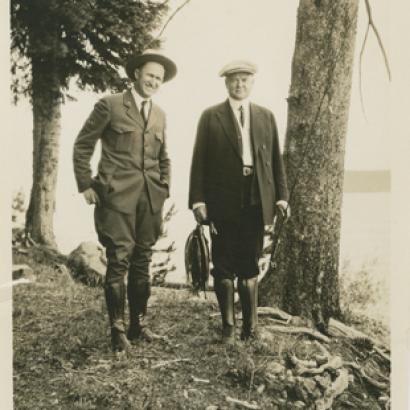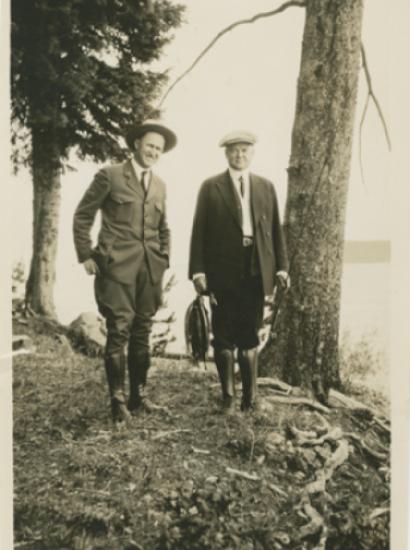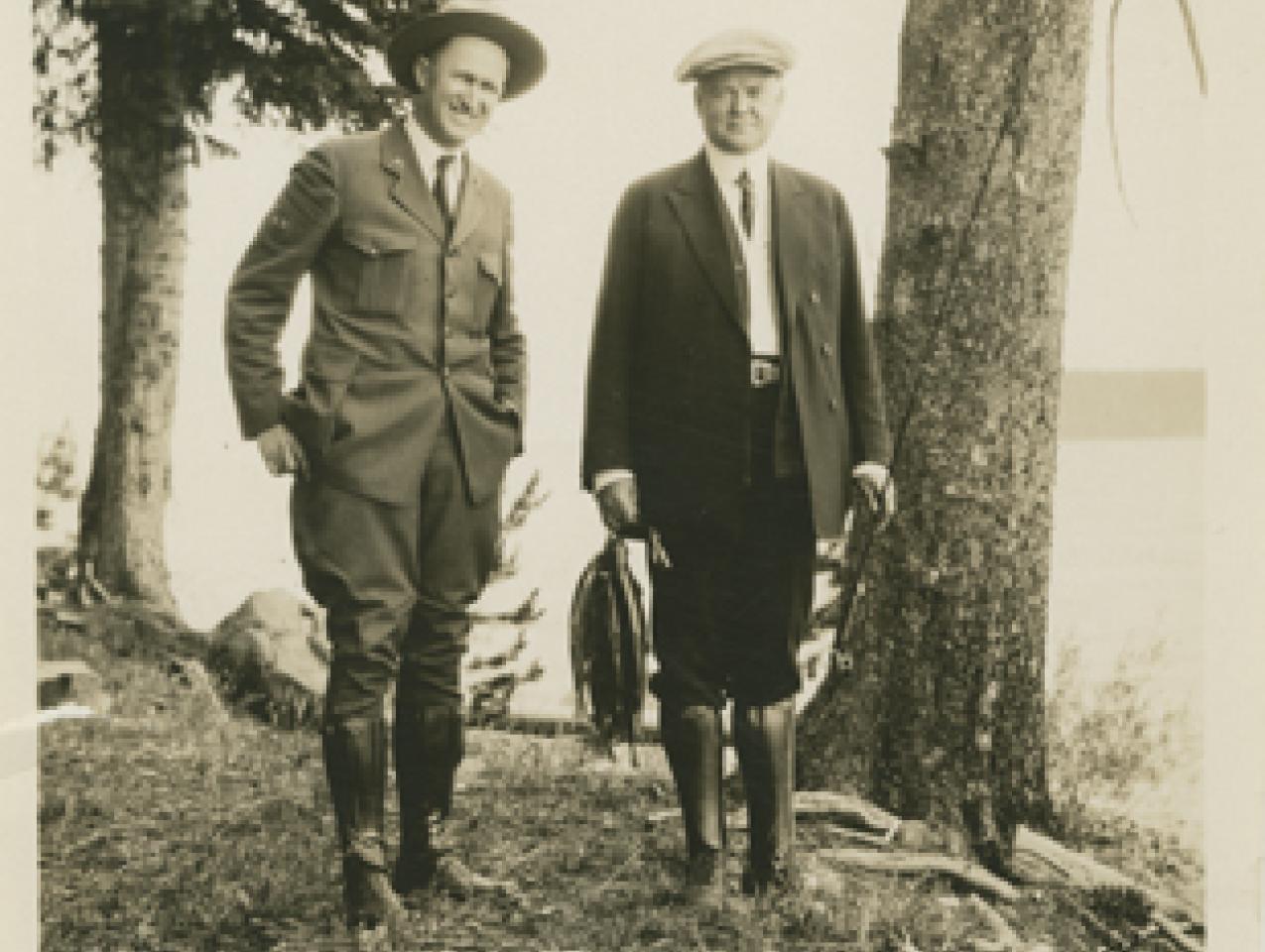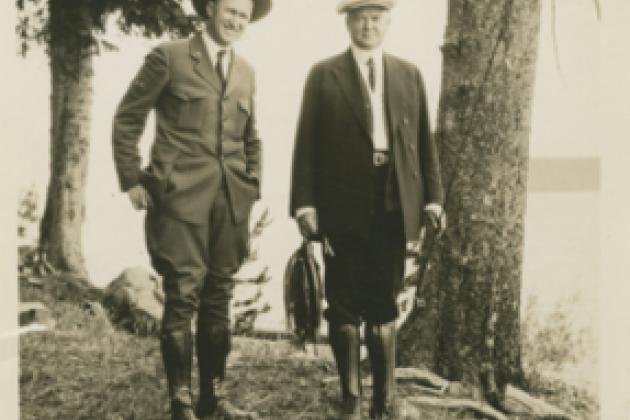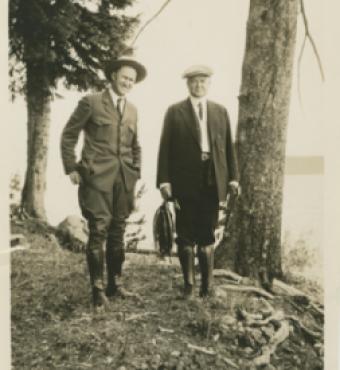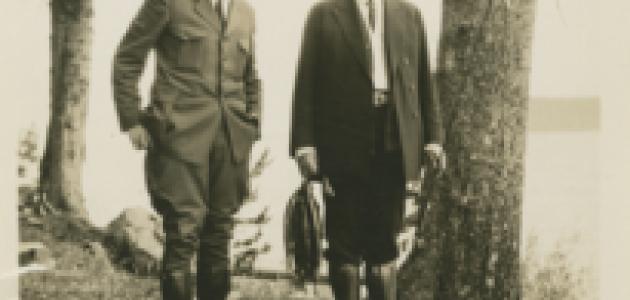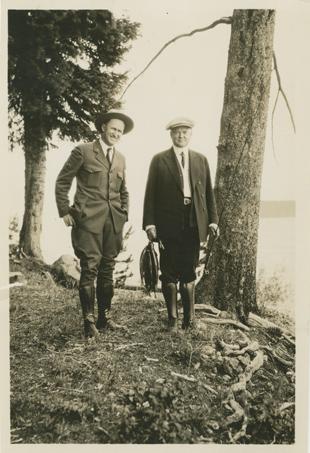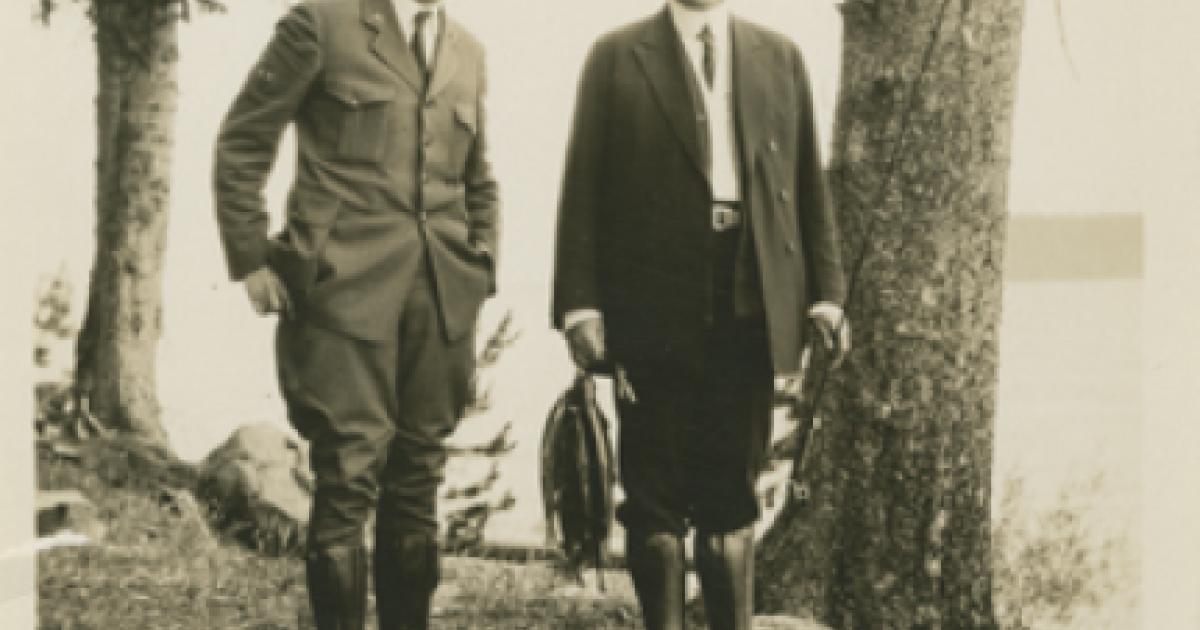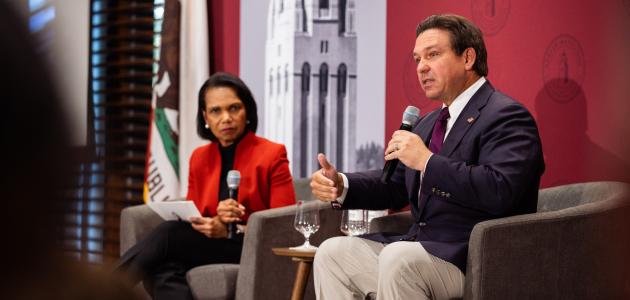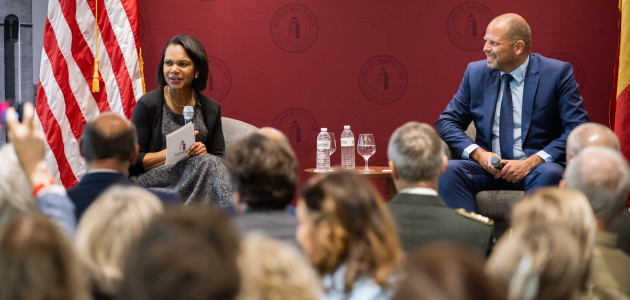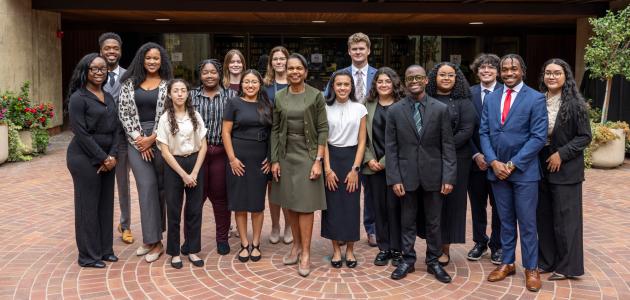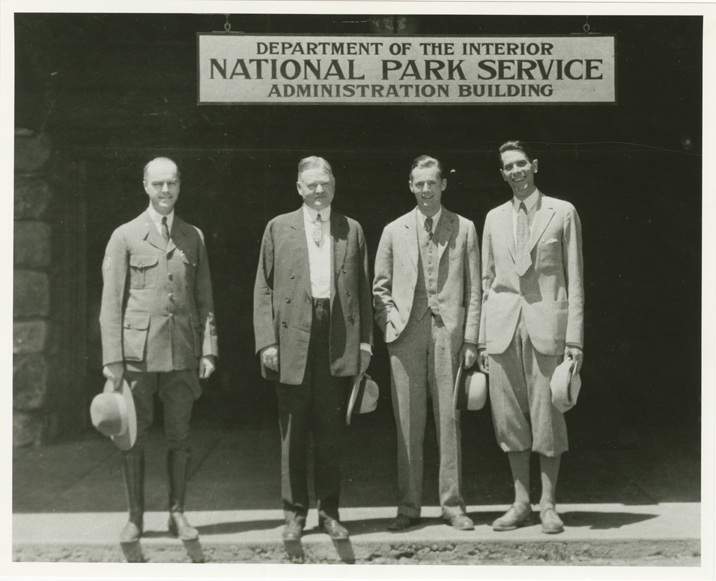
August 25th marks the one-hundred-year anniversary of America’s National Park Service, a federal bureau of the United States Department of the Interior dedicated to the preservation of America’s most beautiful parks and most significant national monuments. Established through an act signed by President Woodrow Wilson in 1916, the National Park Service was the culmination of a conservation movement begun by the naturalist president Theodore Roosevelt, who though born in New York City spent many of his formative years in the west—an experience that prompted him to campaign tirelessly for the protection of areas such as Yellowstone and Yosemite from the encroachment of lumber and mining trades. While many of the well-known parks in the American West had been protected prior to 1916 by acts of Congress, the establishment of the National Park Service opened the door for even more geologically and historically significant areas of the country to be protected.
In the early years of the park service, one of the bureau’s biggest supporters was another transplanted westerner, Herbert Hoover, who moved from Iowa to Oregon at the age of eleven, and spent his childhood largely out of doors: hiking, horseback-riding, swimming, and—his particular favorite—fishing. Hoover’s love of the land inspired him to study geology as part of the first, “Pioneer” class at Stanford, and his subsequent, successful career in the mining industry gave him unique knowledge of the ecological exploitation that could be wrought upon unprotected lands. Coming from a Quaker family that frowned upon playing cards, consuming alcohol, and reading literature that was not the Bible, Hoover had been encouraged to spend his youthful leisure hours in the salubrious outdoors, which his family believed to improve physical health, moral fiber, and spiritual understanding. Hoover would carry this belief in the improving nature of outdoor recreation into his term as President, expanding the park system and encouraging Americans to seek spiritual renewal within the great geologic wonders of the country. When the Depression hit in 1929, the parks also became an inexpensive getaway for struggling families. The thrift of camping, combined with the rise of car culture, raised the number of park visitors from 3.4 million in 1929 to 3.8 million in 1932. To meet the demand for economical recreation, Hoover campaigned aggressively for establishing new parks in the east, protecting and expanding existing parks, and including significant historical sites and monuments within the park service. During his presidency national forests were expanded by more than two million acres, and land designated for new national parks and monuments increased by forty percent. Hoover also laid the groundwork for eastern parks that would be established after his term as president, including the Great Smoky Mountains, Shenandoah, and Everglades parks.
The holdings at Hoover Library & Archives reveal that in addition to hoping that engagement with nature would help assuage some of the anxiety of economic strife and sinking morale during the Depression, Hoover’s engagement with the National Park Service also stemmed from a lifelong passion for the outdoors, a pre-presidency career in the Department of the Interior that yielded a deep understanding of the aspirations of the park system, personal involvement with American conservation movements, and, in particular, a long friendship with Horace Albright, a leading environmentalist whom Hoover would name as director of the National Park Service in 1929. Long before the inexpensive holiday came to be coveted by Americans struggling with hardship or penury, Hoover grappled with issues related to the pragmatism of conservation movements in America, the environmental consequences of tourism, the use of products of the parklands for national need, and the economic role of leisure within a capitalist society.
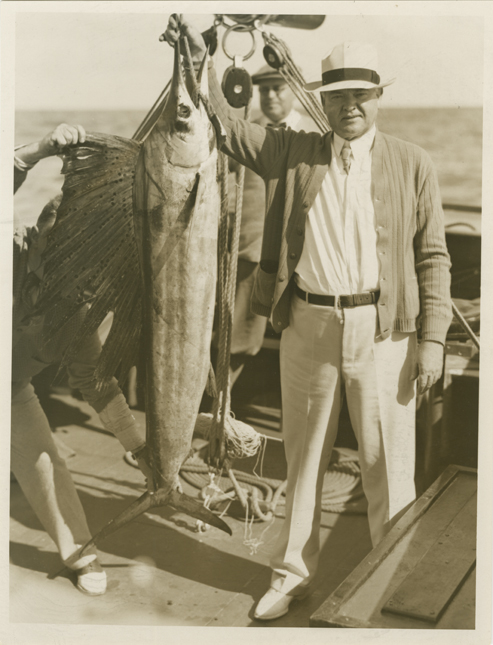
Recreation and Renewal
As Secretary of Commerce from 1921 to 1928, Hoover spent nearly a decade advancing the idea that capitalist leaders in an industrial society should encourage workers to live meaningful lives—and that much of the fulfillment Americans sought was captured during leisure time. In the decade of the 1920s per capita income rose nearly 30 percent, productivity per factory man-hour increased by 75 percent, and the work week was reduced by four percent. Cars cut down commute times; newfangled gadgets such as vacuum cleaners and dishwashers were cheap and reduced time spent on household chores. In the post-WWI industrial, consumer society, Americans had more money and more time than ever before: what to do with it?
Hoover’s answer to this question was to advocate the healthy, self-improving outdoor activities he had enjoyed as a child and which he believed warded off moral and societal degeneration: fishing, hiking swimming, camping, archery. National playgrounds being necessary for productive play, Hoover campaigned for the expansion of the national park service by arguing that if Americans could learn to use leisure to moral and spiritual advantage, they would reaffirm the cultural values that were threatened by the increased affluence of modern consumer society. For Hoover, who believed individualism to be the superior principle to organizing a high-functioning society, efficient use of leisure time was essential. Successful use of leisure created more successful individuals—a belief which, for Hoover, married conservation to the goals of a thriving consumer society.
Unlike many of his colleagues at the Department of the Interior, therefore, Hoover valued the national park system more for its recreational than extractive value. Instead of considering the parks as vaults of natural resources that could be exploited by the country in times of crisis (an idea popular with many leading policy makers of the period), Hoover believed that the parks served primarily for uplifting amusement: a Coney Island built of rock, tree, and mountain. Hoover’s dedication to exploring the great outdoors both as a recreational and economic asset would put him in league with many of the leading environmentalists of the day.
One of Hoover’s most successful collaborations with a conservation group grew out of his lifelong passion: fishing. Hoover emerged as a leading figure in the Izak Walton League, a group of angling outdoorsmen and women who formed a significant voice in public debate over environmental issues in the 1920s. Named for the seventeenth-century author of The Compleat Angler, the Izak Walton League was organized in 1922 by a Chicago fisherman and advertising agent, Will H. Dilg. Unlike older conservation organizations such as the National Audubon Society (founded in 1905) and the Sierra Club (1892) that peaked at a few thousand members in the 1920s, the Izak Walton League, driven by the enthusiasm of Dilg, accrued a membership of 100,000 by 1925 and became the dominant extragovernmental conservation force of the 1920s. The Walton League’s journal Outdoor America featured the finest nature writers of the period, and their coverage of environmental issues would often be considered in public policy debates. In addition to articles about fishing, the journal covered such issues as water pollution, wetland draining, forest fires, reforestation, and ecologically friendly camping. Herbert Hoover, one of the league’s first and most dedicated members, contributed a short essay about scientific conservation and fisheries to the first issue of Outdoor America published in 1922.
In 1924, Hoover also became president of the National Park Association (NPA), an organization established in 1919 by a generous donation given by Stephen Mather, the first director of the National Park Service. The NPA worked primarily as a lobbying group that sought to keep the parks free of commercial development—a goal that made many in the group wary of a president who was also Secretary of Commerce. In his letter accepting the presidency of the NPA Hoover wrote, “Recreation grounds and natural museums are as necessary to our advancing civilizations as are wheat fields and factories. Indeed, I should like to see the association not alone devote itself to defense of areas that have been set aside by our Government for perpetual use in these purposes, but to expand its activities in the promotion of other forms of recreational areas.” Hoover soon clashed with other members of the organization who believed that the association’s purpose was to advocate for the protection of land—which meant deterring tourism, which brought litter, pollution, and erosion. Hoover, however, firmly believed in the value of outdoor recreation for physical, mental, and moral health, and persisted in promoting civilian use of the parks. At a 1924 conference organized to promote outdoor activities, Hoover emphasized “constructive recreation” that would fill the increasing hours of leisure available to Americans:
“Now it seems that one of the by-products of our increasing production and standardization of living is greater leisure. Every decade shows that through the development of science and invention, of elimination of waste, and of improved organization of commerce and industry, we increase our production per capita and consequently our standards of living, and parallel with this increase every decade shows a decrease in the average hours of work by American people. Consequently they have a larger and increasing period of leisure. This leisure must be provided for by increased facilities of recreation and education. It will be of no avail to us to show increased leisure without constructive occupation during that period, for leisure, which is idleness, will generate a disastrous train of degeneration. So that constructive recreation which improves physical strength, which creates stimulation of mind and strengthens the moral fiber of our people is just as important as their efforts in labor.”
Hoover’s argument (idleness is the hand of the devil) shows obvious religious influence, but also mimics the ideas put forth by the popular Boy Scout and Girl Scout movements of the time period (indeed, Hoover’s wife Lou Henry Hoover served as president of the Girls of America in the 1920s and 1930s): outdoor recreation, with the benefit of building health and wholesomeness, produces good citizens. Hoover believed that an active and athletic America was an America that functioned with common sense and optimism. In lieu of passive pursuits such as watching movies and organized sporting events (both of which began to soar in popularity in the 1920s), Hoover advocated expeditions to the outdoors that would lend Americans the “spirit that our people need in times of suspicion and doubt.” Many years before the stock market crash would halt the decadence of the roaring twenties, Hoover prophetically argued that sustaining vim and vigor would help individuals when forced to face difficult times.
Hoover sustained his interest in the effects of material well-being on moral well-being throughout the 1920s, and as a president-elect in 1929 he sponsored a major study of leisure that was carried out by sociologist Jesse Frederick Steiner. By October of 1929, however, Steiner’s findings would be rendered catastrophically moot. With modern industrial America thrown into economic depression and moral despair, excess leisure became a relic of the decade coming to a close.
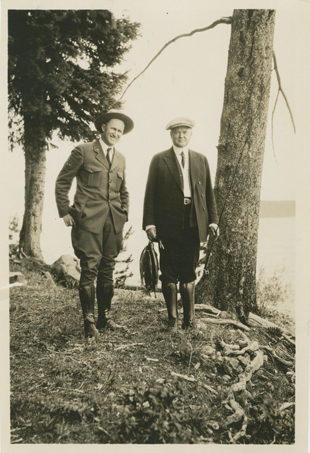
Hoover and Horace Albright
Of the many materials at Hoover Archives that document the thirty-ninth president’s love of nature and the outdoors, perhaps the most illuminating and intimate is the transcript of an interview with Horace Albright, director of the National Park Service during Hoover’s administration. Like Hoover, Albright was an avid angler and, lucky for the researcher, a talented storyteller. His interview, part of the Herbert Hoover Oral History collection at the archives, is replete with colorful tales from more than four decades of friendship with the Hoovers.
Albright first met Herbert Hoover in 1919 when, as a young man, Albright worked under the legendary first director of the National Park Service, Stephen Mather. Albright had been an instrumental deputy to Mather during the latter’s ardent campaign to secure legislation for the NPS (achieved in 1916) and assisted Mather through a rocky start that was overshadowed by war and the frequent loss of employees who enlisted in the army. The most dire of Albright’s wartime concerns, however—the one that inspired him to seek desperate help from Hoover, then head of the U.S. Food Administration—was that a faction of legislators in Washington DC had proposed killing and meat packing the abundant elk in Yellowstone Park to use as food for doughboys overseas. Outraged by this threat to the park’s animals (and fearful for the precedent such an exploitative practice might set), Albright implored Hoover to intervene. Hoover emphatically agreed that slaughtering the animals in Yellowstone was a drastic—and unnecessary—measure and issued a statement that the demands of wartime did not yet determine that parks be mined for resources. Instead, Hoover suggested voluntary rationing—already at that time jocularly called “Hooverizing”—that would create surplus food for fighters. Relieved, Albright thanked Hoover and in exchange for his help gave him significant tips about fishing holes in Yellowstone, Albright’s favorite park. Later that year, Albright became superintendent of Yellowstone Park, and Hoover became one of his most frequent guests and favored fishing partners. Saving the elk began a personal and professional relationship that would have enormous benefits for the flourishing of the park service.
During one of his many early conversations with Albright on the topic of fish, Hoover learned that Yellowstone was the only park in the park system that had a federal fish hatchery, one of the oldest hatcheries of the American West. As Secretary of Commerce (one that installed an aquarium in the Department of the Interior as soon as he arrived), Hoover visited the hatchery with President Calvin Coolidge—a trip that provided for much discussion of the economic benefits of hatcheries, as well as daily angling adventures with Albright. While casting their lines with Coolidge, Hoover and Albright lobbied to start a fish hatchery in Yosemite (the hatchery would be established in 1927). Albright recalled that even when fishing, Hoover was on the job—often fishing in a double-breasted blue serge suit. He also always brought a pad and pencil for recording ideas, taking notes, and making lists of tasks to be done—or, in this case, of hatcheries promised.
As Hoover took office in early 1929, the directorship of the NPS opened suddenly as Stephen Mather suffered a stroke that forced him to resign. Hoover immediately courted Horace Albright to lead the NPS. Hoover was afraid, however, that Albright would not take the directorship because he would be forced to leave his beloved Yellowstone for Washington DC. Only after much cajoling—and threats: “What will happen to Yellowstone if someone incompetent directs the NPS?”—did Albright concede to take the directorship and cross the country from western geysers to eastern city blocks.
The teaming of Albright with Hoover was exceedingly productive: together they worked closely with the Bureau of Fisheries, lobbied to keep airports out of the parks, and convinced legislators that historic sites (battlegrounds and battleships, for example) should come under the auspices of the National Park Service. During Hoover’s administration the size of national forests expanded by more than two million acres, and the land designated for national parks and monuments increased by forty percent. Together Hoover and Albright established Waterton-Glacier and Isle Royale Parks, and expanded Yellowstone, Yosemite, Bryce Canyon, and Carlsbad, among others. They also established nearly two dozen national monuments, including Arches, the George Washington birthplace, Sunset Crater, Appomattox Courthouse, White Sands, and Death Valley. Hoover also lobbied tirelessly for expanding the park system in the east, laying the groundwork for parks in the Shenandoah Valley, the Great Smoky Mountains, and the Everglades. Additionally, Hoover and Albright showed a genius for courting support for the NPS in the private sector and at the state level. At least in part because of his friendship with Hoover, philanthropist John D. Rockefeller Jr. made generous donations of land and money to the NPS, and convinced his wealthy colleagues to do the same. Great Smoky Mountains National Park, for example, was established with 50 percent donations from North Carolina and Tennessee and 50 percent donations from Rockefeller. Rockefeller and his colleagues would also often raise funds to buy private lands within the parks and then donate them to the NPS.
Hoover also personally expanded the park system by establishing (with $120,000 of his own money) a rustic presidential retreat in the east. With Albright's advice (and fishing recommendations!) Hoover settled on the Rapidan River area of Virginia—a site he would later donate as part of Shenandoah National Park. Hoover used the Rapidan Camp—nestled one hundred miles from Washington in the beautiful Blue Ridge Mountain range—for both recreation and diplomacy; here he pitched horseshoes with Charles Lindbergh, went horseback riding with Will Rogers, and planned the 1930 London Naval Conference, one of the most important post-WWI disarmament efforts, while sitting on a log in the woods with British Prime Minister Ramsay MacDonald.
During his interview for the Herbert Hoover Oral History Project, Albright relates a colorful anecdote that illustrates how Hoover's innate talent for problem solving and ardent love of nature were a happy combination for the citizens of the country. Albright reports that one night while on a stroll on the White House lawn Hoover came across an injured opossum, which he rescued and brought inside. The following day he invested the care of the possum to a few local children (Hoover, who had been orphaned at a young age, maintained a sympathy for children throughout his life). In turn, the children made the presidential possum the mascot of their high school—which proceeded to have an undefeated football season. As the story of the lucky mascot exploded in the media, Hoover was flooded with requests for possums sent from high schoolers across the country. At first baffled by the predicament of possum shortage, Hoover quickly solved the problem using the organizing skills he honed in his earlier humanitarian work: he hired the local children of the rural Rapidan area to source possums to send to the high schools. At the rate of one dollar per possum—not insignificant during the Depression—the president soon could satisfy the need for mascots from coast to coast. Hooverizing indeed!
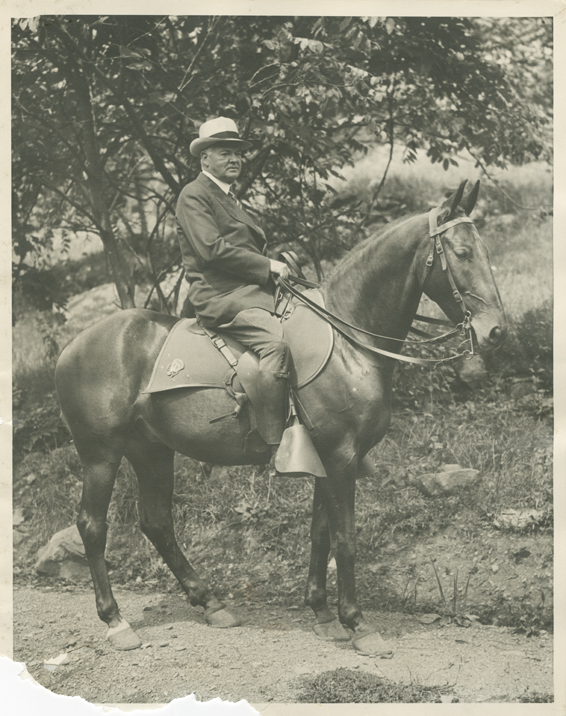
A Lifelong Commitment
Hoover remained an active outdoorsman and proponent of the park system long after leaving office in 1933; photographs from the Herbert Hoover collection at Hoover Archives show him fishing with friends in parks across the country until his death in 1964. After his term as president he continued speaking to conservation groups in support of establishing new parks and expanding existing ones, and was heavily involved in the twenty-year-long movement to incorporate Jackson Hole National Monument as part of Grand Teton National Park (which finally took place in 1950). In his latter years, with his responsibilities as president, secretary of commerce, and food administrator behind him, he spoke expansively about finding a sense of the sublime in nature; in a draft of a 1951 speech entitled “Men Are Equal Before Fish,” Hoover wrote that spending time out of doors “is the chance to wash one’s soul with a pure air, with the rush of the brook, or with the shimmer of the sun on blue water. It brings meekness and inspiration from the decency of nature . . . a mockery of profits and egos, a quieting of hate.” And perhaps most importantly, “a rejoicing that you don’t have to decide a darned thing until next week.” For Hoover, the National Parks allowed Americans to improve themselves as individuals while also escaping the overwhelming demands of daily life in an industrialized society. The spiritual profit of experiencing the parks caused him to champion the fledgling National Park Service as, in the words of fellow westerner and Stanford alumnus Wallace Stegner, “Absolutely American, absolutely democratic . . . . The best idea we ever had.”




